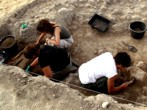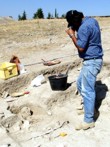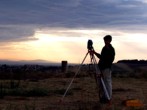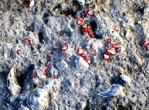|
|
| Excavation |
 Excavations have been organised every year since 2000 and have involved the participation of many researchers and students from various Greek and foreign Institutes and Universities. The investigation focuses on five main areas, the first on the north-eastern slope of the hill, the second towards the north, the third at the top of the hill, the fourth on its south side and the fifth on the south-eastern slope. To date some 560 square metres of the mound have been investigated, bringing to light important finds and a wealth of information about the prehistoric inhabitants of Paliambela. The investigation continues with the simultaneous study of the material and plans for future expansion. Excavations have been organised every year since 2000 and have involved the participation of many researchers and students from various Greek and foreign Institutes and Universities. The investigation focuses on five main areas, the first on the north-eastern slope of the hill, the second towards the north, the third at the top of the hill, the fourth on its south side and the fifth on the south-eastern slope. To date some 560 square metres of the mound have been investigated, bringing to light important finds and a wealth of information about the prehistoric inhabitants of Paliambela. The investigation continues with the simultaneous study of the material and plans for future expansion. |
| |
| Excavation procedure |
The investigation of a prehistoric settlement is not a simple procedure limited to the discovery of architectural remains and moveable finds (pottery, figurines, tools, etc.). The collection of data related to people's everyday activities constitutes a central aim of a modern archaeological excavation. The very undertaking of the excavation demands exceptionally methodical and careful work, which is carried out using particularly intensive techniques.
All the investigated layers are carefully dry-sieved as the excavation is being carried out, and all finds one centimetre in size and over are collected. A significant part of each layer is wet-sieved, in order to distinguish the very small finds which are not easily detected in the trenches during excavation (beads), and to separate out the fragile organic residues (seeds, charcoal traces) which contain important information. Furthermore, soil samples are collected with a view to the detailed analysis of their sediments, and samples of charcoal are taken wherever it is uncovered with an aim to date the age of the layer.
|
| |
| Documenting the excavation |
Excavation is a process that destroys the object of its study. Since it is impossible to repeat, the systematic recording of every piece of information is essential in order to lead to useful conclusions. Each excavator keeps a diary which describes the progress  of the work undertaken and his/her observations about the particular area they are excavating (also called the unit of excavation) , along with a catalogue of the finds and architectural constructions uncovered. The frequent photographing of the trenches in an essential part of the documentation. Finally, recordings are made at regular intervals during the excavation work which serve as an archive of the excavation method and of the speculation involved in the excavation procedure. of the work undertaken and his/her observations about the particular area they are excavating (also called the unit of excavation) , along with a catalogue of the finds and architectural constructions uncovered. The frequent photographing of the trenches in an essential part of the documentation. Finally, recordings are made at regular intervals during the excavation work which serve as an archive of the excavation method and of the speculation involved in the excavation procedure.
|
| |
| Digital technology |
| Digital technology plays a central role in the Paliambela programme. Precise co-ordinates are taken for all finds using digital photogrammetry. It is worth mentioning that all the co-ordinates are recorded on the basis of the national network. The topographic plotting of all the architectural finds is also done digitally, as is the stratigraphy of the site. |
 The methodology followed was developed through a previous research programme of the University of Thessaloniki's Research Committee in collaboration with P. Patia, a lecturer at the Polytechnic School.The exploration of the possibility of wireless networks for the documentation of the excavation procedure in the future is the subject of a parallel investigation, and it is supported by the experience of the research team and by its participation in the PAST European programme. The methodology followed was developed through a previous research programme of the University of Thessaloniki's Research Committee in collaboration with P. Patia, a lecturer at the Polytechnic School.The exploration of the possibility of wireless networks for the documentation of the excavation procedure in the future is the subject of a parallel investigation, and it is supported by the experience of the research team and by its participation in the PAST European programme. |
| |
| Laboratory support |
 In a modern excavation, the work is not limited to the field. It is complemented by simultaneous work in the laboratory, where the staff proceeds to an initial cataloguing of the finds and informs the excavators about the soils they are digging. For example, it is possible to give almost immediate information about deposits rich in seeds, while decisions concerning the excavation are supported by the quick supply of information as regards dating, the integrity, and use of the layers that can be drawn from an initial examination of the pottery. In this way the interpretations of the excavators in the field are checked, and the study of the finds progresses for the duration of the excavation. In a modern excavation, the work is not limited to the field. It is complemented by simultaneous work in the laboratory, where the staff proceeds to an initial cataloguing of the finds and informs the excavators about the soils they are digging. For example, it is possible to give almost immediate information about deposits rich in seeds, while decisions concerning the excavation are supported by the quick supply of information as regards dating, the integrity, and use of the layers that can be drawn from an initial examination of the pottery. In this way the interpretations of the excavators in the field are checked, and the study of the finds progresses for the duration of the excavation. |
|
|





